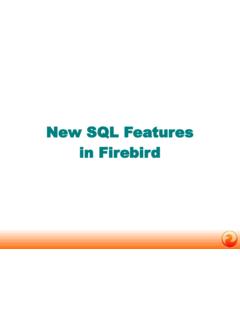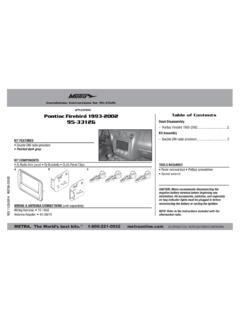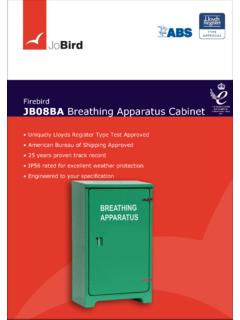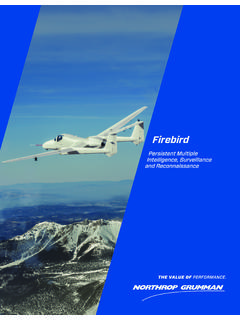Transcription of Firebird 3 Quick Start Guide
1 Firebird 3 Quick Start GuideIBPhoenix EditorsFirebird Project members25 April 2016, document version covers Firebird 32 Table of ContentsAbout this Guide .. 3 The Firebird licenses .. 3 Installing Firebird .. 4 Installation kits .. 4 Installing the Firebird server .. 4 Installing multiple servers .. 7 Testing your installation .. 7 Performing a client-only install .. 10 Default disk locations .. 11 Linux .. 11 Windows .. 12 Server configuration and management .. 14 User management .. 14 Security .. 17 Administration tools .. 22 Working with databases .. 22 Connection strings .. 22 Connecting to an existing database .. 26 Creating a database using isql .. 27 Firebird SQL.
2 29 Protecting your data .. 33 Backup .. 33 How to corrupt a database .. 33 How to get help .. 35 How to give help .. 35 The Firebird Project .. 35 Appendix A: Document History .. 37 Appendix B: License notice .. 43 Alphabetical index .. 443 About this guideThe Firebird Quick Start Guide is an introduction for the complete newcomer to a few essentials for gettingoff to a Quick Start with a Firebird binary kit. The Guide first saw the light as Chapter 1 of the Using Firebirdmanual, sold on CD by IBPhoenix. Later it was published separately on the Internet. In June 2004, IBPhoenixdonated it to the Firebird Project. Since then it is maintained, and regularly updated, by members of the Firebirddocumentation you read on, verify that this Guide matches your Firebird version.
3 This document covers Firebird all other Firebird versions, get the corresponding Quick Start Guide at Firebird licensesFirebird is a free, open-source database management system, but free does not mean that everything is per-mitted. The use of Firebird is governed by two licenses: the IPL (InterBase Public License) and the IDPL (InitialDeveloper's Public License). The first one covers the parts of the source code that were inherited from InterBase;the second applies to the additions and improvements made by the Firebird Project. Both licenses offer similarrights and restrictions. In short: Use of the software is free, even for commercial purposes. You may also redistribute the software, separatelyor with a product of your own, but you may not claim ownership or credit for it. Any license notices includedwith Firebird must remain intact.
4 You may modify and recompile the Firebird source code or parts of it. You may distribute such modifiedversions, but if you do so, you must document your modifications and make them publicly available, at nocost, under the same license as the original code. You may include Firebird source code (modified or not) in a larger work and distribute that larger work,in source and/or compiled form, under a license of your own choosing. You need not publicize the sourcecode for the entire larger work, but you must fulfill the license conditions for the parts that were taken fromFirebird, whether they were modified or notice that the above is a simplified overview. Only the original license texts are legally binding. Youcan find them here: (IPL) (IDPL) Firebird 3 Quick Start4 Installing FirebirdThe instructions given below for the installation of Firebird on Windows and Linux should be sufficient for thevast majority of cases.
5 However, if you experience problems or if you have special needs not covered here, besure to read the Release Notes. This is especially important if you are upgrading from a previous version orif there are remnants of an old (and maybe long gone) InterBase or Firebird installation floating around yoursystem (DLLs, Registry entries, environment )Installation kitsAt the Firebird website the installation kits have names (Windows executable installer) (Windows zip kit for manual installation) (Windows executable installer, 32 bits) (Linux RPM kit) (Linux compressed tarball) (Linux RPM kit, 32 bits) (Mac OS-X 64-bit package) bbbbb is the build number (32483 for the initial release) and p the packaging number (usually0 or another low one-digit number). Firebird 3 packages will also undoubtedly wind up in various Linux distributions and their online will have their own naming the Firebird serverBefore installationIt is almost always advisable to uninstall any previous Firebird installations completely (after you've read thenext paragraph!)
6 And also hunt the Windows system dirs for old copies of and Ifyou're using Linux, the uninstall scripts should have removed any copies and/or symlinks in /usr/lib[64],but it won't hurt to look if anything named libfbclient.* or libgds.* is still lying , you should be aware that Firebird 3 won't open databases that were created by older versions. Sobefore taking down your existing setup, you should back up all your databases in order that you can restorethem later under Firebird 3 Quick Start5 You may also want to back up your old security database Firebird 3 comes with an SQLscript (located in misc/upgrade/security) that will upgrade the old securitydatabase to Firebird 3, preserving all information except SYSDBA's and except any passwords. For more infor-mation, see Compatibility Issues :: Upgrading a Security Database in the Firebird 3 Release drivesThe Firebird server and any databases you create or connect to must reside on a hard drive that is physicallyconnected to the host machine.
7 You cannot locate components of the server, or any database, on a mapped drive,a filesystem share or a network filesystem. (Well, you can, but you shouldn't, and this technique isn't coveredhere.)NoteYou can mount a read-only database on a CD-ROM drive but you cannot run Firebird server from script or programAlthough it is possible to install Firebird by a filesystem copying method such as untarring a snapshot buildor decompressing a structured .zip archive it is strongly recommended that you use the distributed releasekit (.exe for Windows, .rpm for Linux), especially if this is the first time you install Firebird . The Windowsinstallation executable, the Linux rpm program and the script in the official . for variousPosix platforms all perform some essential setup tasks. Provided you follow the installation instructions correct-ly, there should be nothing for you to do upon completion but log in and go!
8 Server modesSome installers ask you to choose between Classic, SuperClassic and Superserver mode. What are they? Classic mode (aka MultiProcess) involves a single listening process that spawns off an additional process foreach client connection. Using a locking mechanism, it allows shared connections to database files. SuperClassic (ThreadedShared) is a single server process. Client connections are handled by separate threads,each having their own database page cache. Other processes ( embedded servers) may open the samedatabase simultaneously (hence the Shared). Superserver (ThreadedDedicated) is also a single server process with threads handling client is a single, common database page cache. The server requires exclusive access to each database fileit opens (hence the Dedicated).
9 Each mode is fully stable and there is no reason to categorically prefer one to the other. Of course you may haveyour own specific considerations. When in doubt, just follow the installer default for now. Changing the servermode later can be done via the configuration file and requires a restart but not server mode can even be configured per database (consult the Release Notes for details).NoteUsers of Firebird or earlier: please notice that as from Firebird 3, Superserver fully supports the use ofmultiple processors/cores out of the box, so lack of SMP support is no longer a reason to avoid 3 Quick Start6 Installing on WindowsMake sure you run the installer program as Administrator ( right-click on the executable and choose Runas Administrator ) or you may run into permission problems later!
10 On Windows server platforms Firebird will run as a system service by default, but during installation you canalso choose to let it run as an application. Don't do this unless you have a compelling installer will also ask if you want to enable authorization for legacy ( ) Firebird clients. If securityis a concern (as it should be), don't allow this or allow it only temporarily while you upgrade your existingclients to Firebird The legacy connection method sends passwords over the wire unencrypted; it also limitsthe usable length of the password to 8 installation you have the option of providing a password for Firebird 's superuser, SYSDBA. Firebirdpasswords may be up to 255 bytes long, but due to the nature of the hashing algorithm the effective length is around 20 bytes, so it's not very useful to enter a password that's much longer than that.













